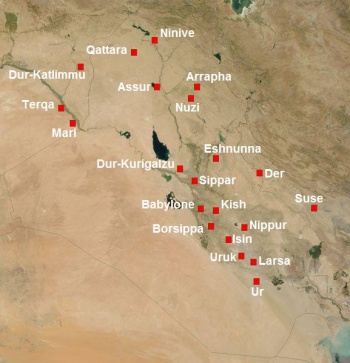Sippar
Da Ufopedia.

Sippar (la sumerica Zimbir "città degli uccelli", la moderna Tell Abu Habbah in Iraq), era un'antica città sumerica e poi babilonese sulla riva est dell'Eufrate, a 60 km a nord di Babilonia.
La città era divisa in due parti, "Sippar del dio sole" and "Sippar della dea Anunit", la cui scoperta fu di Hormuzd Rassam nel 1881 a Abu Habba, 16 miglia a sud-est di Baghdad.
Sippar viene chiamata Sepharvaim nell'antico testamento, che allude alle due parti della città its dual form.
Two other Sippars are mentioned in inscriptions, one of them being "Sippar of Edinu," which may have been an additional quarter of the city. It is possible that one of the "Sippars" might be identified with Akkad, the capital of the first Semitic Empire.
The main god of the city was the Sumerian Sun god, Utu (Shamash in Akkadian).
One of its kings was Enmeduranki, who was said to have ruled many years before the Flood.
Archaeology
A large number of cuneiform tablets and other artifacts have been found in the ruins of the temple of Shamash, which was called E-Babara by the Sumerians, Bit-Un by the Semites. This temple is thought to be the world's oldest bank, in operation until at least 1831 BC [1].
Xisuthros, the "Chaldean Noah", is said by Berossus to have buried the records of the antediluvian world here--possibly because the name of Sippar was supposed to be connected with sipru, "a writing". And according to Abydenus, Nebuchadnezzar excavated a great reservoir in the neighbourhood. Here too was the Babylonian camp in the reign of Nabonidos.
Pliny (Natural History 6.30.123) mentions a sect, or school of Chaldeans called the Hippareni. It is often assumed that this name refers to Sippar (especially because the other two schools mentioned seem to be named after cities as well: the Orcheni after Uruk, and the Borsippeni after Borsippa), but this is not universally accepted [2].
References
1^ Benjamin Bromberg, The Origin of Banking: Religious Finance in Babylonia, The Journal of Economic History, 1942, volume2, issue1, pagg. 77–88
2^ "It is usually assumed that the Hippareni refers to Sippar (Ptolemy's Sippara), but even that requires proof, since the change of ‘s’ to ‘h’ is strange." R. D. Barnett, Xenophon and the Wall of Media, The Journal of Hellenic Studies, 1963, volume 83, pag. 14, doi 10.2307/628451